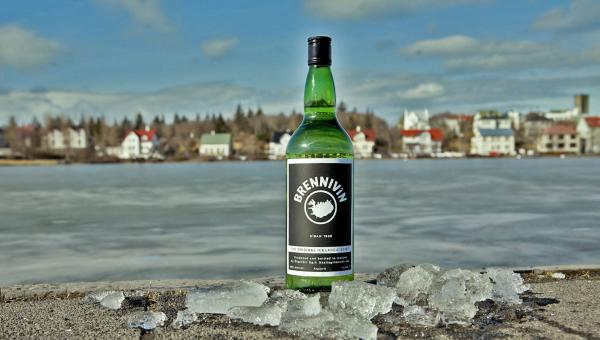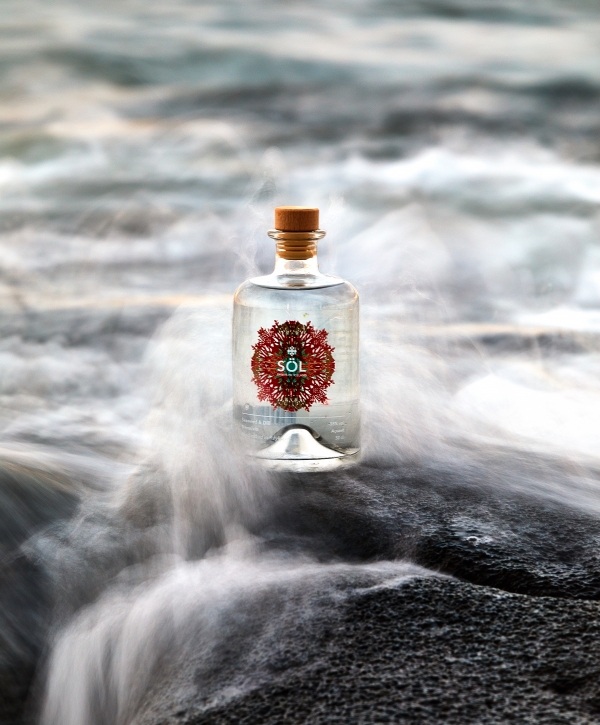Brennivín, sometimes called “Black Death” is the signature spirit of Iceland. But don‘t let the difficult to pronounce name or the not all too inviting nickname and black label scare you away!
Most foreign visitors who strike up a conversation with a local at an Icelandic bar are likely to be encouraged to try the caraway spiced spirit. Some visitors to Iceland have even taken a liking to the drink, whether it is the uniquely minimalistic design on the label or the taste. The bottle and its contents certainly have their rough charm: Michael Madsen is seen drinking Brennivín in Quentin Tarantino‘s Kill Bill 2.
What exactly is Icelandic Brennivín?
Icelandic Brennivín is a type of akvavit or aquavit (ákavíti in Icelandic), a type of flavoured spirit primarily produced in Scandinavia. The dominant flavour in akvavit is either dill or caraway, but akvavit can contain other spices as well, producing complex spirits which are perfect for sipping chilled, but can also be used in cocktails.

Icelanders have been drinking brennivín since at least the 17th century when Danish merchants began importing large quantities of Danish akvavit to the country. It quickly became the most popular alcoholic drink in Iceland, a title it retained for several centuries, or until the 1980s.
How does Brennivín differ from Vodka?
The crucial difference between vodka and brennivín is that the former is an unflavoured distilled spirit, made from fermented substance which uses grains, potatoes, or sometimes fruit and/or sugar. Brennivín in turn is a flavoured spirit.
The dominant flavour in Icelandic Brennivín is cumin and caraway, which gives it a taste some find reminiscent of anise or liquorice. Few Icelanders would agree, as Icelandic liquorice is both sweeter and has a stronger salmiak taste.
How is it drunk?
Brennivín has been consumed in Iceland since the 15th or 16th century, and from the 17th century it became the most popular alcoholic drink in Iceland, a status which it maintained until the 1980s: Until the mid-1980s it was the single most popular alcoholic drink in Iceland.
Read more: Söl and Hvönn: Distilling the spirit of Iceland into small-batch, hand-crafted Brennivín

Traditionally Icelanders have drunk brennivín straight up, or mixed in soft drinks like Coca-Cola. It is safe to say that brennivín in Coke is an acquired taste, and no modern day Icelander would order this drink at the bar.
A more refined way to enjoy brennivín and the subtle flavours of the herbs, is to sip it chilled from a small shot glass. It goes well with fermented foods and traditional Icelandic foods. A classic pairing is brennivín and fermented shark, but it also goes perfectly with pickled herring. In recent years adventurous bartenders have also been creating some excellent brennivín cocktails.
Brennivín and the beer-ban
A major reason for the popularity of brennivín was that it was the cheapest booze available to Icelanders: A bottle of brennivín bought at the State Alcohol Monopoly (ÁTVR) gave you more alcohol for each hard-earned króna than any other drink!
Read more: An Icelandic microbrew revolution
During those years Icelanders found many uses for brennivín, all of which included getting drunk. A great example is the beer-like: When prohibition was lifted in 1935 beer remained banned until 1989. In the 1980s, however, enterprising restaurateurs began selling a drink which imitated beer, marketed as beer-like.
Beer-like was essentially a cocktail, made up of the 2.25% abv low alcohol beer which is still sold in grocery stores, and a mixture of stronger liquors to raise its alcohol volume. Most importantly, vodka, bourbon, and of course brennivín.
What does Brenivín mean?

The word vodka is derived from the Slavic word voda, simply „water“, and the word aquavit in turn is derived from the Latin aqua vitae, the “water of life”.
The word Brennivín has a more fiery translation, as it literally means “Burned wine” or “burning wine”, referring to the fact that brennivín is produced in stills, over open flame, unlike wine or beer, which is fermented, without the application of fire!
Why is it called “black death”?
Icelanders frequently refer to brennivín as “black death”. The origins of this nickname can be traced decades back. When prohibition, introduced in 1918 was lifted in 1935 the newly established State Alcohol Monopoly (ÁTVR) began producing its own brennivín.
To make the drink as unappealing as possible it was bottled in green bottles with a non-inviting black label. The black label has been maintained since then with only minimal changes, despite the fact that the State Brennivín factory having been privatized in 1991.
While the „Black“ in the name „black death“ comes from the label, the „death“ part comes from the fact that the term for being passed out from excessive alcohol consumption is to „die“.
While we at Iceland Insider encourage our readers to immerse themselves as best they can in Icelandic culture and society while in Iceland, we urge people to drink responsibly and skip trying out the experience referred in the name of our national spirit!
Brennivín, sometimes called “Black Death” is the signature spirit of Iceland. But don‘t let the difficult to pronounce name or the not all too inviting nickname and black label scare you away!
Most foreign visitors who strike up a conversation with a local at an Icelandic bar are likely to be encouraged to try the caraway spiced spirit. Some visitors to Iceland have even taken a liking to the drink, whether it is the uniquely minimalistic design on the label or the taste. The bottle and its contents certainly have their rough charm: Michael Madsen is seen drinking Brennivín in Quentin Tarantino‘s Kill Bill 2.
What exactly is Icelandic Brennivín?
Icelandic Brennivín is a type of akvavit or aquavit (ákavíti in Icelandic), a type of flavoured spirit primarily produced in Scandinavia. The dominant flavour in akvavit is either dill or caraway, but akvavit can contain other spices as well, producing complex spirits which are perfect for sipping chilled, but can also be used in cocktails.

Icelanders have been drinking brennivín since at least the 17th century when Danish merchants began importing large quantities of Danish akvavit to the country. It quickly became the most popular alcoholic drink in Iceland, a title it retained for several centuries, or until the 1980s.
How does Brennivín differ from Vodka?
The crucial difference between vodka and brennivín is that the former is an unflavoured distilled spirit, made from fermented substance which uses grains, potatoes, or sometimes fruit and/or sugar. Brennivín in turn is a flavoured spirit.
The dominant flavour in Icelandic Brennivín is cumin and caraway, which gives it a taste some find reminiscent of anise or liquorice. Few Icelanders would agree, as Icelandic liquorice is both sweeter and has a stronger salmiak taste.
How is it drunk?
Brennivín has been consumed in Iceland since the 15th or 16th century, and from the 17th century it became the most popular alcoholic drink in Iceland, a status which it maintained until the 1980s: Until the mid-1980s it was the single most popular alcoholic drink in Iceland.
Read more: Söl and Hvönn: Distilling the spirit of Iceland into small-batch, hand-crafted Brennivín

Traditionally Icelanders have drunk brennivín straight up, or mixed in soft drinks like Coca-Cola. It is safe to say that brennivín in Coke is an acquired taste, and no modern day Icelander would order this drink at the bar.
A more refined way to enjoy brennivín and the subtle flavours of the herbs, is to sip it chilled from a small shot glass. It goes well with fermented foods and traditional Icelandic foods. A classic pairing is brennivín and fermented shark, but it also goes perfectly with pickled herring. In recent years adventurous bartenders have also been creating some excellent brennivín cocktails.
Brennivín and the beer-ban
A major reason for the popularity of brennivín was that it was the cheapest booze available to Icelanders: A bottle of brennivín bought at the State Alcohol Monopoly (ÁTVR) gave you more alcohol for each hard-earned króna than any other drink!
Read more: An Icelandic microbrew revolution
During those years Icelanders found many uses for brennivín, all of which included getting drunk. A great example is the beer-like: When prohibition was lifted in 1935 beer remained banned until 1989. In the 1980s, however, enterprising restaurateurs began selling a drink which imitated beer, marketed as beer-like.
Beer-like was essentially a cocktail, made up of the 2.25% abv low alcohol beer which is still sold in grocery stores, and a mixture of stronger liquors to raise its alcohol volume. Most importantly, vodka, bourbon, and of course brennivín.
What does Brenivín mean?

The word vodka is derived from the Slavic word voda, simply „water“, and the word aquavit in turn is derived from the Latin aqua vitae, the “water of life”.
The word Brennivín has a more fiery translation, as it literally means “Burned wine” or “burning wine”, referring to the fact that brennivín is produced in stills, over open flame, unlike wine or beer, which is fermented, without the application of fire!
Why is it called “black death”?
Icelanders frequently refer to brennivín as “black death”. The origins of this nickname can be traced decades back. When prohibition, introduced in 1918 was lifted in 1935 the newly established State Alcohol Monopoly (ÁTVR) began producing its own brennivín.
To make the drink as unappealing as possible it was bottled in green bottles with a non-inviting black label. The black label has been maintained since then with only minimal changes, despite the fact that the State Brennivín factory having been privatized in 1991.
While the „Black“ in the name „black death“ comes from the label, the „death“ part comes from the fact that the term for being passed out from excessive alcohol consumption is to „die“.
While we at Iceland Insider encourage our readers to immerse themselves as best they can in Icelandic culture and society while in Iceland, we urge people to drink responsibly and skip trying out the experience referred in the name of our national spirit!







